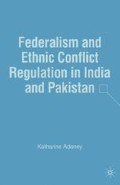Abstract
The previous chapter revealed the conflicts between the Congress and the League over the appropriate constitution for a united India, ultimately failing to agree on an acceptable form. The history of the partition of India has been extensively covered in a variety of different ways (Khosla 1949; Ali 1967; Inder Singh 1990; Moon 1961; Butalia 2000; Hasan 1993) and need not detain us here. Suffice it to say that hundreds of thousands of people were killed traveling between the two countries that were created in August 1947, and up to ten million people crossed the newly created border in both directions. The legacy of the partition was extensive. Pakistan was cast as the seceding state and was dependent on India for the transfer of resources. Pakistan literally had to build the institutions of state from scratch and possessed a high degree of insecurity, which had extensive ramifications for the operation of those state structures (Jalal 1995, 49). Partition also demonstrated the violence that could occur through the mobilization of religious identity, but the partition along religious lines ensured that different identities became prominent within the two states. In particular, linguistic and regional identities would pose challenges to the stability of the federations, compounded by the geographical separation of the two wings of Pakistan, as can be seen in the map below.
[The constitution could be] both unitary as well as federal according to the requirements of time and circumstances.
(Dr. B. R. Ambedkar1)
Sardar Patel characterised the impatient champions of the redistribution of provinces on a linguistic basis as the assassins of nationalism.
(Vanhanen 1992, 72)
If Pakistan is to return to the past to safeguard the future, it is not to the mythical theocratic intentions of its founders. It is rather to the original ideas of the 1940 Lahore Resolution that emphasised the decentralisation of power to the federating units of a Muslim state. Secondly it is to the consociational, accommodationist politics of the Muslim League’s Unionist Party rivals in the Punjab during the 1940s.
(Talbot 1998, 5)
Access this chapter
Tax calculation will be finalised at checkout
Purchases are for personal use only
Preview
Unable to display preview. Download preview PDF.
Copyright information
© 2007 Katharine Adeney
About this chapter
Cite this chapter
Adeney, K. (2007). Partition: Differences in Federal Design. In: Federalism and Ethnic Conflict Regulation in India and Pakistan. Palgrave Macmillan, New York. https://doi.org/10.1057/9780230601949_4
Download citation
DOI: https://doi.org/10.1057/9780230601949_4
Publisher Name: Palgrave Macmillan, New York
Print ISBN: 978-1-349-99953-8
Online ISBN: 978-0-230-60194-9
eBook Packages: Palgrave Political & Intern. Studies CollectionPolitical Science and International Studies (R0)

